Disease Facts
- Fungal disease caused by Fusarium virguliforme.
- Has spread to most soybean-growing states and Ontario, Canada.
- Continues to spread to new fields and larger areas of infected fields.
- Ranked second only to soybean cyst nematode (SCN) in damage to soybean crop.
- Fungus colonizes only crown and roots of the plant.
- Above-ground symptoms are caused by a toxin produced by the fungus and translocated throughout the plant.
- Severity varies from area to area and field to field.
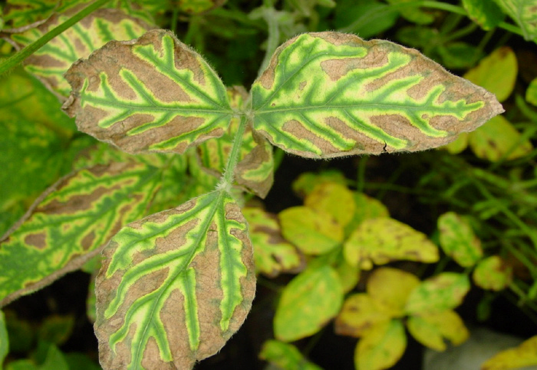
Figure 1. Soybean leaf showing classic symptoms of sudden death syndrome infection, with yellow and brown areas contrasted against a green midvein and green lateral veins.
Conditions Favoring Disease Development
- Cool, moist conditions early in the growing season often result in higher disease incidence.
- Favorable disease conditions may result from early planting, high rainfall and/or low-lying, poorly drained or compacted field areas.
- If SCN is also a problem in the field, disease may be more severe.
- Infection occurs early in the season, but symptoms usually do not appear until mid-summer.
- Appearance of symptoms often associated with weather patterns of cooler temperatures and high rainfall during flowering or pod-fill.
Fusarium virguliforme Disease Cycle
- Fungus survives in crop debris and as mycelia in the soil.
- Survives best in wet areas such as poorly drained or compacted field areas.
- Fungus enters roots early in the growing season.
- Infection may be facilitated by wounds from SCN, insects or mechanical injury.
- Fungus colonizes the root system.
- Fungus overwinters in diseased soybean residue.
Impact on Crop
- Soybean seed yield is reduced as:
- Plants lose leaf area and leaves drop prematurely.
- Roots deteriorate, reducing water/nutrient uptake.
- Flowers and pods abort, resulting in fewer pods and seeds.
- Seeds may be smaller, and late-forming pods may not fill or mature.
Root Symptoms
- A blue coloration may be found on the outer surface of taproots due to the large number of spores produced.
- These fungal colonies may not appear if the soil is too dry or too wet.
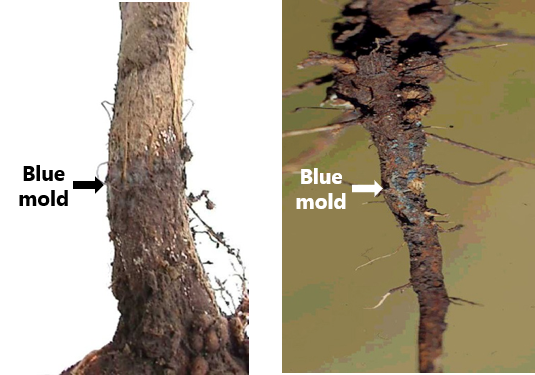
Figure 2. Root and stem of soybean plants with blue Fusarium virguliforme fungal colonies present at soil surface line.
- Splitting the root reveals cortical cells have turned a milky gray-brown color while the inner core, or pith, remains white.
- General discoloration of the outer cortex can extend several nodes into the stem, but its pith also remains white.
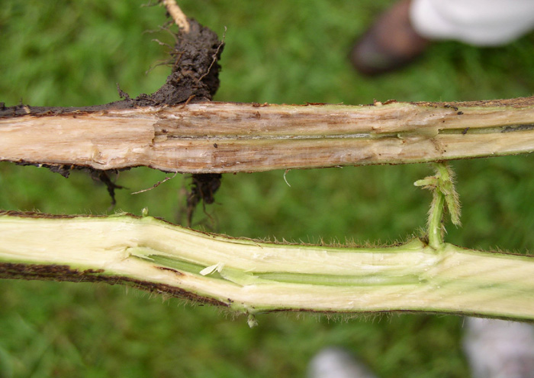
Figure 3. Split soybean stem on top shows stem symptoms of sudden death syndrome infection. Split stem on bottom is healthy.
Leaf and Plant Symptoms
- Leaf symptoms first appear as yellow spots (usually on the upper leaves) in a mosaic pattern.
- Yellow spots coalesce to form chlorotic blotches between the leaf veins.
- As chlorotic areas die, leaves show yellow and brown areas contrasted against green veins.
- Affected leaves twist and curl and fall from plants prematurely.
- Flowers and pods abort, and seeds are smaller.
- Later-developing pods may not fill, and seeds may not mature
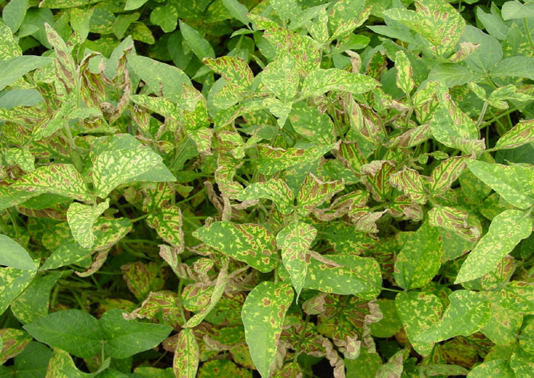
Figure 4. Soybean plants infected with sudden death syndrome. Necrotic areas of leaves dry rapidly. Leaves drop from the plant prematurely, but leaf petioles remain firmly attached to the stem.
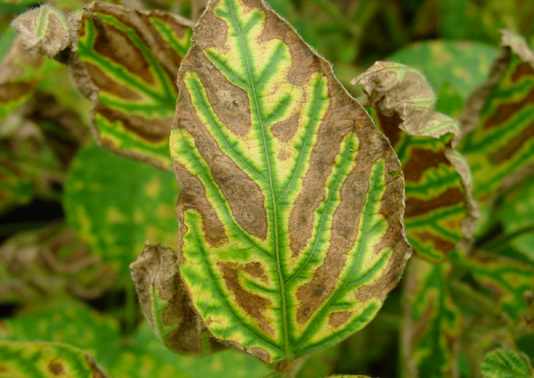
Figure 5. Soybean leaf showing symptoms of sudden death syndrome infection. Drying of necrotic areas can cause curling of affected leaves
Management
Use a combination of practices:
- Select SDS-resistant varieties.
- Pioneer has developed elite soybean varieties with improved SDS resistance.
- Soybean breeders have selected for genetic resistance in multiple environments with high levels of natural SDS infection.
- Pioneer rates its varieties and makes ratings available to customers.
- Ratings range from 4 to 8 (9 = resistant), indicating very good resistance is available in elite soybean varieties.
- Your Pioneer representative can help you select suitable varieties.
- Manage soybean cyst nematode (SCN).
- Plant varieties resistant to both SDS and SCN.
- Improve field drainage and reduce compaction.
- Evaluate tillage systems. Where possible, some tillage may be needed to bury infected residue.
- Reduce other stresses on the crop.
- Plant the most problematic fields last in your planting sequence.
- Foliar fungicide cannot protect plants from SDS.

Figure 6. Soybean leaf showing early symptoms of sudden death syndrome infection











